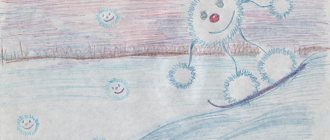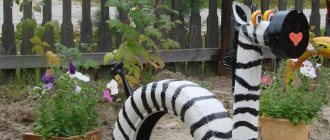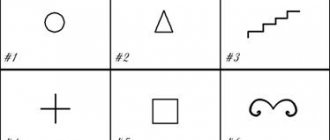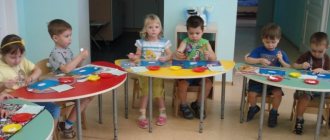MAGAZINE Preschooler.RF
Multi-level didactic games and exercises in visual artsPrepared by: teacher of MBDOU No. 152 Rogova S. A. Orenburg 2021
Konstantin Balmont wrote:
Perhaps all of nature is a mosaic of flowers? Perhaps all nature is different voices? Perhaps all nature is just numbers and features? Perhaps all nature desires beauty?
These words were written more than a century ago and the task of the teacher is to help this charm, the beauty of nature, but for this, according to Saloukhin, “You must wait until beauty itself invites you to be an interlocutor, and not slide through it fussy, hasty glance.
Teachers know that children show increased interest in the visual arts, and the main task is to raise an active, creative child.
And one of the main tasks is to maintain spontaneity, sincerity, and the desire for creativity; children are characterized by an active attitude to the events depicted, some even voice the events depicted.
An important point in the learning process is familiarization with national characteristics in art, with the decorative and applied creativity of the peoples of Russia, as well as an idea of the talent of each person of the nation.
Each nation passes on to new generations its vision of beauty, housing, dishes, and clothing. This is not only the development of creative abilities, but also the development of interest in culture as a whole. To solve these problems, the main goals can be identified:
- Motivational activity: when the child conveys his impression of the ability to build a composition and develop it, choose a color scheme.
- Comparison is the main way to activate thinking and fully reveal its individuality, through qualities that must be taken into account, others must be educated, and others must be developed in the process of creative activity.
- Game activity: here you can recall the words of Sukhomlinsky “like a child without a game, without a fairy tale”
- research activity: gone are the days when children painted only with gouache and watercolor
Not least important, consolidating skills and developing creative abilities is the creation of a developmental environment. In accordance with the Federal State Educational Standard
We know that children’s first drawings are made up of scribbles, geometric figures, lines not connected with each other, by the age of three they comprehend their scribbles and begin to consider them as an image of things and the child’s capabilities begin to grow, like a growing cloud, and our task is to help the development of these abilities.
Our main task is to enrich the experience of artistic and productive activity at all levels, to promote the development of artistic technologies based on the integration of intellectual activity and the development of manual skills.
In accordance with the Federal State Educational Standard, when working with children, the individual abilities of each child, their interests and preferences are taken into account. A prerequisite for exploring artistic creativity is the ability to see color. First, I invite the children to look at the rainbow and read the poems:
“The rooster saw a rainbow, what a beautiful tail
The ram saw a rainbow, what a high bridge
And the horse looks at the rainbow, the horseshoe is large
The river looks like a rainbow and there is a river in the sky"
I offer the children stripes and make a rainbow out of them; if the children find it difficult (with a low or average level of development), I invite them to choose the colors of the rainbow, then a large drawing of a rainbow is placed in the ecological corner and I invite the group to find the colors of the rainbow on the street. Children with a high level of development can be offered cold shades for “Snowman” , and warm colors for “Sunshine” , and as a conclusion, you can offer “Rainbow Dance” with ribbons of the corresponding color.
The next stage of getting to know the shades is the game “Round Dance of Colors” .
“I’ll take three basic colors, these colors are not simple, all the rest are made up of them, if red and yellow make friends, what new paint will come out, bring your girlfriend here, if yellow and blue make friends, what new paint will come out, bring your girlfriend here, if red and blue If you make friends, what new paint will come out, bring your girlfriend"
For children with a high level of development, you can introduce the following complication, introduce the game “Seasons” . Where children create a three-dimensional picture of autumn and this helps to understand the volume of the picture in the future, when they draw a landscape, they will draw not only in the foreground, but use the entire space of the sheet.
For children with a low level of development, you can offer the game “Autumn Palette” . Where they can choose appropriate fall colors.
Children's acquaintance with folk art begins with preliminary work, when children examine the elements of paintings and get acquainted with the products of folk craftsmen, mastering the color palette.
Children with a low and average level of development can be asked to first select elements of a painting, for example, Dymkovo, then decorate a young lady or a lamb, and children with a high level of development can be asked to sculpt from clay and then paint them.
Acquaintance with Gzhel painting begins with the introduction of simple elements: a grid and a cage with dots. You can invite a child who finds it difficult to move his finger on a sheet of paper from top to bottom from right to left, and children with a high level of development can decorate the dishes with elements of painting, and subsequently paint the sculpted products. Also, continuing to introduce folk art, you can offer the game “Funny Horse” , matching the horse with the selected painting, this is mainly used for children of low and intermediate level.
To consolidate your cutting and sculpting skills, you can start with finger games. Children timidly separate pieces of clay and plasticine, and begin to process them, and very quickly these pieces, with the help of rolling, rolling out, begin to take shape, and they happily string their beads or cakes onto wire or thread.
Finger games are a very important part of developing fine motor skills. These games are very emotional, exciting, they contribute to the development of speech and creative activity, thereby developing dexterity, the ability to control one’s movements, and the ability to concentrate attention on one type of activity.
Four-year-old children can only use their fingers, but children of older preschool age can be offered: balls, cubes.
Finger game “My Family”
This finger is grandpa, This finger is grandma, This finger is daddy, This finger is mommy,
This finger is me, that’s my whole family.
Children alternately bend their fingers one at a time, and when finished, twist their fist.
Finger game "Hide and Seek"
Fingers played hide and seek and removed their heads
This is how the heads were removed.
Children rhythmically bend and straighten their fingers, first on one hand and then on the other. Older children can be asked to put animal figures on their fingers. Finger games can also be used in cutting skills, for example, first ask to name all the geometric shapes in the picture, and then fold them in different directions, then cut them along the fold lines. From the resulting figures, offer to lay out a rug, classify them by color and shape.
For children with an average level of development, you can offer the game “Find the right color” . Children must trace the outline of the proposed fruit or vegetable with their finger and find the corresponding color. And for children with a high level of development, the game “Assemble a Vase” , which later helps children to better navigate, cutting out exactly the same objects with scissors.
In each group there are children with advanced development, which is also provided for by the developmental environment created in the group, this can be eco-plastics, the use of improvised and waste materials, you can offer children pictures from pencil shavings, the children draw the outline of trees with a house, and then their imagination begins to work. Eggshells, leaves, a collection of stones can serve as a unique process of getting used to the world of creativity. Our work involves the full disclosure of the child’s individual qualities, some of which must be taken into account, others must be nurtured, and others must be developed.
| Next > |
Material on the topic “Games aimed at developing the memory of preschoolers”
Games aimed at developing the memory of preschoolers
Development of voluntary visual memory
- Game "Memorize and Draw"
Progress of the game: children are invited to look and remember how the matryoshka decorated its scarf (each has its own example, accessible to visual perception). You can trace the pattern with a pen or pencil. And then the children are invited to decorate their scarf with the same pattern.
- Drawing a pattern from memory.
Progress of the game: A pattern is drawn on the sheet. Invite the children to look at this pattern for 1 minute. Then remove the pattern and ask the children to reproduce it from memory. (Attention and fine motor skills also develop)
- Game “Abstract Antoshka”: the teacher asks the child to look carefully at the picture and then draw it from memory. Afterwards the child tells what he drew and what the boy put on wrong. It is very important that the child compares his drawing with the sample and concludes whether he remembers everything well.
- Game “Draw pictures from memory”: the teacher shows several pictures, each of which has a combination of geometric shapes (you can start with 3 pictures, gradually increasing their number). Each picture is presented for a period of 5 to 10 seconds; after all the pictures are presented, the teacher asks the children to draw everything that the children remember. This task can be modified by using a set of cards, each of which has a different sequence of geometric shapes. The child reproduces the sequence after presenting the card.
Expansion of auditory memory capacity
- Exercise “Cascade of words (numbers)”
- An exercise similar to the previous one, based on numbers (can be used to form elementary mathematical concepts). You can vary the complexity of tasks through additional instructions such as: “Repeat the numbers in reverse order.”
- Game “I put it in a bag”:
Progress of the game: an adult, starting the game, says: “I put apples in the bag,” the next one repeats what was said and adds his own, etc. until reproduction of the entire chain becomes inaccessible to children. The contents of the bag can be changed depending on the topic of the lesson.
- Game “Walking in the garden (forest, vegetable garden, etc.)”
Purpose of the game: Development of involuntary visual memory.
Progress of the game: show the children an image of the garden (without setting it to memorize), then ask the children to list which trees, shrubs, and vegetables they came across. Then you can show cards with pictures of different plants and ask them to choose only those that have been named. Remove the cards and ask the children to list the plants in the order in which they were named.
Formation of effective memorization techniques
- Exercise "Classification"
Progress: since the ability to classify objects into various groups at this age has already been formed, the teacher proceeds directly to the stage of interiorization of the action (for example, asks the child to look at pictures or listen to words, and then say into which groups these words can be divided). Then the child is asked to use grouping of objects for memorization, i.e. Relying on the names of the groups to which the child classified objects or words, remember the objects or words themselves. At the initial stages of work, you should use a limited number of words (subject images), which can be clearly divided into groups.
Formation of the ability to organize logically unrelated material into a single semantic system
- Technique of semantic correlation and search for associations.
The teacher offers the children a number of words that are not related in meaning, and asks them to first compose a story that contains all these words. The teacher shows the children an example, and then the children do this work on their own. When the ability to compose a story based on a series of words (object images) is formed, the teacher asks the children to compose the story in their minds at the moment the teacher reads the words (or at the moment the object images are presented), and then to reproduce not the story itself, but only those words that needed to be remembered .
You can ask children to “draw comics” in which certain “heroes” would be present.
A task to search for associations can be as follows: the teacher reads the words, the child remembers them with the help of pictures (he selects a picture for each word, which will then help him remember this word).
A task to search for associations can also be as follows: “Imagine that you are a scout, and you need to remember 8 names (in the future, the number and complexity of names can be increased). Try to connect them with something you already know.”
- Drawing up a plan for the material to be learned: breaking the material down into its component parts, coming up with titles or highlighting a strong point with which the entire content of a given part of the material is associated, linking the parts by their titles into a single chain of associations.
The work is carried out first on the material of short stories with a clearly defined structure, then the speech (or visual) material becomes more complex.
Assignment: The teacher invites the children to listen to a short story, after a short conversation to clarify the specific content, cause-and-effect relationships and hidden meaning, the teacher asks to divide this text into several parts, give them names and explain their decision.
Assignment: The teacher reads the text, the child listens to it and divides it into several parts according to its meaning, then the names of the parts are written out in front of the child and he reproduces the story from memory according to this plan.
- Search for a reference point (when memorizing texts).
Task: the child is offered an abstract, at first glance, drawing, in which there are elements familiar to the child, superimposed on each other. You need to find a foothold and reproduce all the information that is possible.
Assignment: An unfamiliar poem is read to the child, which contains either unfamiliar (or, on the contrary, very familiar) words, an unexpected turn of events, or something else that will attract the child’s attention. It is suggested that you first simply find a fulcrum, then try to memorize the poem with its help.
- Recoding information.
Task: the child is asked to listen to a poem and imagine it in the form of a picture, then questions are asked to find out how much the child remembers the material.
Task: the child is asked to look at the image, describing in words everything that he sees, then they are asked questions about this material.
Development of auditory memory productivity (memorization speed, reproduction accuracy, retention strength)
- Exercise “Remembering tasks”
Here we mean the recall of some speech material perceived by the child by ear, which was offered to the children a week ago or earlier. Returning to events that happened quite a long time ago, to events on which the child’s attention was not specifically focused, is a very effective technique from the point of view of developing long-term memory and developing the strength of storing information. If the teacher periodically returns to repetition. By recalling some information, it will be firmly preserved in the child’s memory.
- Completing tasks in a competitive mode: for example, the teacher names 10 words and asks them to remember them using any memorization techniques convenient for the child, and then calls 9 words in random order and asks those who are ready to finish the chain to raise their hands.
- Children are asked to memorize a short text, and then the teacher reads the same text, but with minor changes (for example, some words are used in a diminutive form, some names are changed, etc.), the children correct mistakes
Development of visual memory productivity (memorization speed, reproduction accuracy, retention strength)
- “Copying the artist.” Children are asked to memorize as quickly as possible a drawing consisting of lines, dots, geometric shapes arranged in disorder, and then reproduce it on a blank sheet of paper from memory. It is advisable to organize an exhibition of children's works and invite the children to choose the winner whose drawing is most similar to the original.
- A return to memory of tasks from a week ago or earlier (to visual material, for example, it is asked to remember which animals were in the picture that the teacher showed in the last lesson, etc.).
- In 1 minute, remember as many details of the image as possible.
Activation of a child’s motor memory
- Game "Puppeteers".
Option 1. The “puppeteer” teacher blindfolds the child and “leads” him like a doll along a simple route, holding him by the shoulders, in complete silence: 4-5 steps forward, stop, turn right, 2 steps back, turn left, 5-6 steps forward, etc. Then the child is untied and asked to independently find the starting point of the route and walk it from beginning to end, remembering his movements.
Option 2. Children can do these exercises in pairs: one is the “puppeteer”, the other is the “doll”.
Option 3. The movements can be gradually made more difficult by increasing the duration of the route and including a number of simple physical exercises: tilt the “doll”, bend your arms, make you sit down, make a full turn over your left shoulder, etc.
Improve tactile perception and memory
- Game "Hide and Seek" (with tactile boards).
Progress of the game: The child is given one tactile board to “feel”, then it is hidden in a row of other 10-12 boards behind a screen or under a scarf, and the child, without seeing, must find and recognize his board by touch.
Development of fine motor skills
- Game "Don't drop it!" (with counting sticks)
Progress of the game: sticks are poured out of the box, the empty box is placed vertically on the table. The child takes 2 sticks with the thumb and forefinger of his right hand and places them on the box, trying not to drop them.
If it works, then with his left hand, using the same fingers, he transfers the sticks to another box. If he succeeds, he tries to do the same with the middle and thumb of both hands (alternately). And then - the ring finger and the thumb, the little finger and the thumb. (If even one stick falls, you must start over.)
If everything was completed successfully, another stick is added (2 + 1 = 3 sticks, etc.).
Developing concentration skills
- Game "Magic Circle".
The teacher invites the children to direct “the ray of their attention” to the star drawn in the circle (“try not to be distracted, look only at the star...”) and holds their attention for as long as possible (from 10 to 30 seconds); then transfers the “ray of attention” to the worm (same time), then to the cross..., then to the stick... and, finally, to the dot.
Game "Hearers".
Children are invited to listen to the sounds that “live” only in the group room, then switch their auditory attention to the sounds that “live” inside the kindergarten (excluding the group), then to the sounds on the territory of the kindergarten (outside the building), then to the sounds in road...
At the end of the chain of switching auditory attention, discuss with the children all the sounds they heard.
Increase your attention span and memory
(the result is achieved by repeating the game options many times)
- Game “Do as I do!” (with counting sticks).
Children play in pairs. Initially, each child has 6 sticks. One, the leader, lays out a random composition from 6 sticks, then shows it to his partner for one or two seconds.
The partner uses his sticks to lay out exactly the same figure from memory. Then the children change roles. If the condition is successfully fulfilled, the number of sticks gradually increases to 12-15.





